Throughout the late 1980s and early 1990s, it sometimes seemed like you couldn’t turn a page in the arts & entertainment section of a local newspaper without seeing an article titled with some variation on “Zap! Pow! Comic Books Aren’t Just for Kids Any More!” While these articles made very clear the huge influence that the 1960s Batman TV series had on the public perception of comic books, they did illustrate that the mainstream press was taking notice of the evolution that was happening in comics.
These local newspaper articles would frequently cite pieces about Frank Miller’s The Dark Knight in high profile culture magazines Rolling Stone and SPIN as evidence that comics had “grown up” and were worthy of serious critical assessment. I myself spent most of the ‘80s and ‘90s extolling the virtues of comics to anyone who would listen, and I frequently brought up those very same Rolling Stone and SPIN articles. It only recently occurred to me that I had never actually read them…
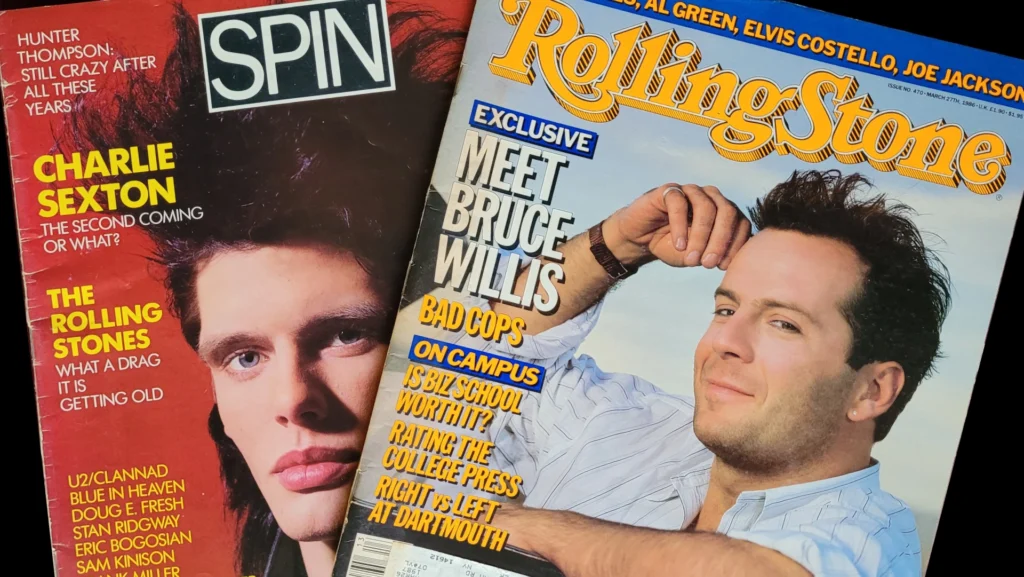
A quick internet search, $30 and a week for shipping later, and I’ve got copies of both magazines in my hands. Let’s see what all the fuss was about.
“Comic Genius,”Rolling Stone issue 470, March 27th 1986
A fresh-faced Frank Miller is nestled among pieces on up-and-coming pop sensations the Bangles, the censorship of drug use in movies, how lame the second season of Miami Vice was, and a feature-length interview with a pre-Die Hard Bruce Willis. The magazine’s contents page even runs with a full-page Batman illustration by Miller and Dark Knight colorist Lynn Varley that would eventually become a limited edition poster and the cover to the first bookstore collection of Dark Knight.
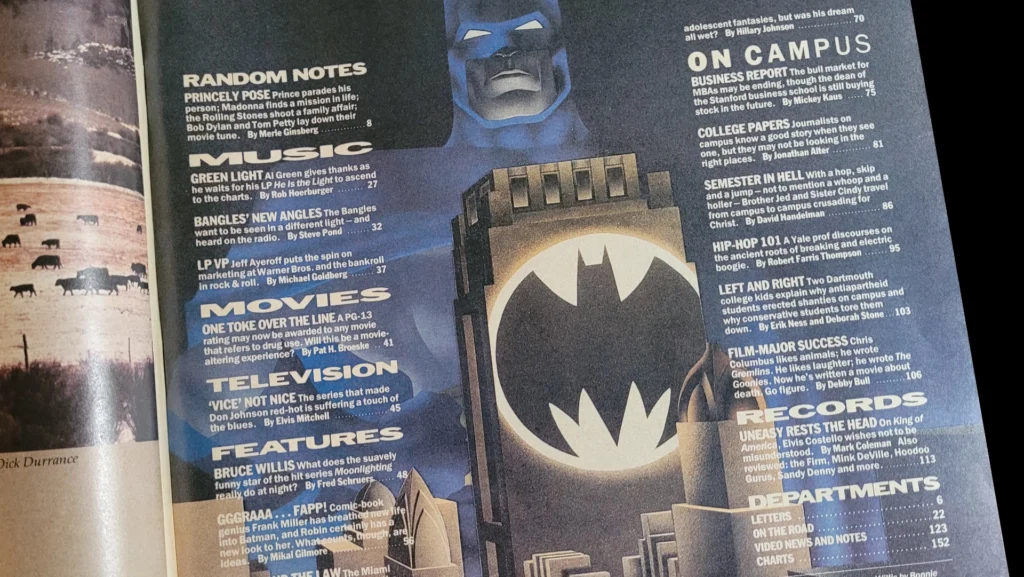
Writer Mikal Gilmore delivers an even-handed and well written short feature. He’s clearly either a comics fan or he’s done his research, as he name-checks Howard Chaykin’s American Flagg!, the Hernandez brothers’ Love and Rockets, Alan Moore’s Swamp Thing, and Art Spiegleman’s Maus as further examples of comics’ newfound sophistication. He expresses only mild surprise that Batman might be worthy of literary merit, and doesn’t once mention the Adam West TV series.
The Dark Knight Returns is pulp fiction of the eldest sort: a comic book. If that sounds like a rather trite or unbecoming format for hard-boiled material of this sort, then think again. In recent years, the comic-book field has undergone perhaps the most wide-ranging and meaningful creative explosion of its fifty-year-plus history, spawning a new generation of storytellers who are among the more intriguing literary and graphic craftsmen of their day.
After getting the reader up to speed, Gilmore gets out of the way and lets Frank Miller explain the rest. What’s really refreshing is how excited he seems to be about the comics medium and its possibilities. “It’s a very exciting time to be doing this work…there’s really no medium I would rather be working in. I’m exactly where I want to be.”
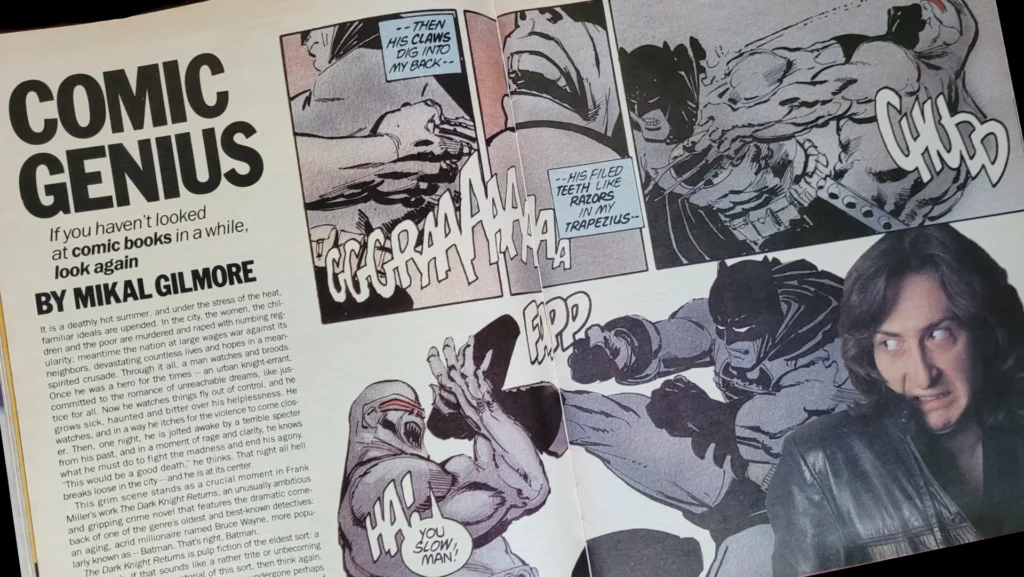
The article includes a brief discussion of Miller’s three-year run on Marvel’s Daredevil and his “defection” to DC Comics to do the ground-breaking but not overly well-received Ronin. He talks enthusiastically about his return to writing Daredevil (for the storyline that will eventually be collected as Born Again), and the changes to that book’s status quo, implying that he had long term plans beyond the seven issues he and artist Dave Mazzucchelli ended up doing.
But The Dark Knight is the main focus of the interview, and it’s interesting to hear Miller talk about his masterpiece while he’s in the middle of working on it.
I’ve completely reworked Batman for the needs of the modern world, though in a way he’s not so different than the man he started out as in 1938. Batman only makes sense as a response to the world being basically a screwed-up place, where all the wrong people are in charge and justice is not served. I think that lines up perfectly with our sense of the world at present.
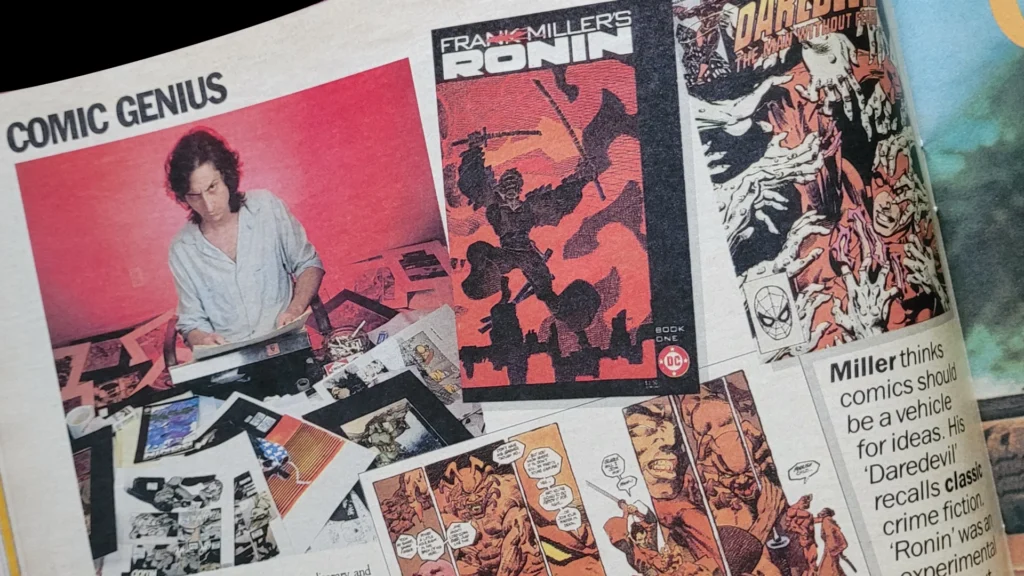
Far from seeming cynical or nihilistic, Miller comes off as energetic and positive, especially when talking about the reason for including a new version of Robin in the story: “…she is what he’s fighting for. She’s young, innocent, untainted and unpoisoned, while he’s clearly a poisoned man, focused entirely on negatives.” His assessment of Superman is a bit more negative, but not nearly as venomous as you might expect: “over the years…he was turned into a superpatriot, until now he clearly represents the Ronald Reagan America.”
Gilmore’s article presents Miller as confident without being jaded, and above all excited about the work he’s doing and the possibilities of the comics medium. He even seems to have a touch of humility. “I simply feel like someone at the beginning of his career who has a great deal more work to do and a great deal yet to learn.”
“Here Comes the Knight,” SPIN volume 2 number 2, May 1986
Founded in 1985 by the son of Penthouse publisher Bob Guccione, SPIN seems to have been established as a direct competitor to Rolling Stone. Ostensibly, SPIN’s purpose was to lean away from Rolling Stone’s more mainstream approach, but they look pretty similar to me. If anything the tone of the pieces in SPIN is a lot more surly, almost to the point of being mean-spirited – it gives the impression of an adolescent desperately trying to be taken seriously as an adult.
SPIN’s article on Frank Miller is much shorter than Rolling Stone’s, a box-out piece that takes up a mere two thirds of a page. From the opening quote, writer Brian Cronenworth seems to want to emphasize The Dark Knight’s over-the-top violence over its literary merits.
“This is the scene in which the Joker feeds poisoned cotton candy to a troop of Boy Scouts,” chuckles Frank Miller, displaying a sheet of rough layouts from his latest big project…a revisionist pop epic about Batman’s middle-aged return from a brooding retirement. The series takes place sometime early in the next century, but it revives the violent film noir tone of the ‘40s. Miller explains: “I’m emphasizing his more malign qualities.” He indicates some horizontal squiggles in the next panel: “Those are the dead boy scouts.”
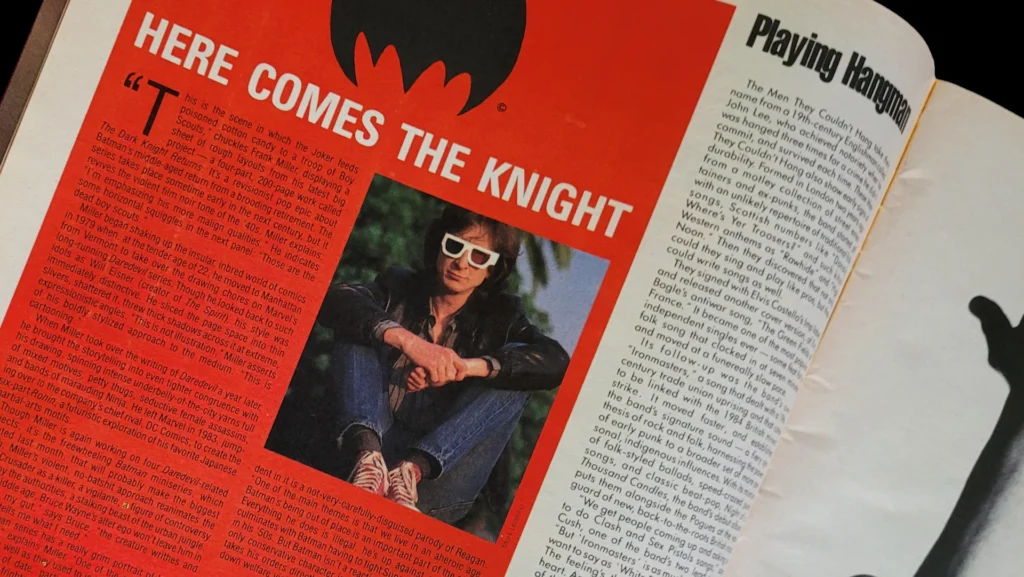
Cronenworth doesn’t seem to have a lot of respect for comics, referring to it as an “insular, inbred world” and he doesn’t cite any examples of the medium’s changing creative landscape. While I suppose it’s possible that Miller just woke up in a bad mood on the day of his SPIN interview, the quotes Cronenworth chooses to use seem a lot more negative than what we saw in Rolling Stone just two months prior. “My Batman series has a really grim portrait of how the world works. One of the reasons comics aren’t doing as well as they used to is that the characters are completely out of date, particularly in social and political terms. We live in frightening times…”
It’s certainly more than possible that each interviewer cherry-picked the quotes from Miller that fit the article they wanted to write – in any case, the SPIN piece comes across as almost juvenile. There is a lot of focus on The Dark Knight’s superficial “grim and grittiness,” and next to nothing on why it is such a groundbreaking work.
Two different views
Throughout the late 1980s and well into the 1990s, mainstream superhero comics took a sharp turn towards the nihilistic and ultra-violent, with characters like the gun-toting Punisher and claw-wielding Wolverine emerging to take the spotlight away from the more moral, but seemingly old-fashioned, heroes. The phenomenal success of Miller’s The Dark Knight and Alan Moore and Dave Gibbons’ Watchmen has taken the blame for much of this, and perhaps rightly so. With the SPIN article, it’s easy to see how nihilistic violence could be the only takeaway from The Dark Knight, completely missing the book’s literary merit as extolled by the Rolling Stone piece.
In the Rolling Stone and SPIN pieces we get two somewhat conflicting views of an artist and his work. These interviews, directly or indirectly, sent thousands of new readers into comic book stores to seek out The Dark Knight. Although I suspect that the more thoughtful Rolling Stone article had a much larger impact than SPIN’s somewhat trite coverage, it’s interesting to note how each piece might have influenced the prospective new readers’ expectations.
